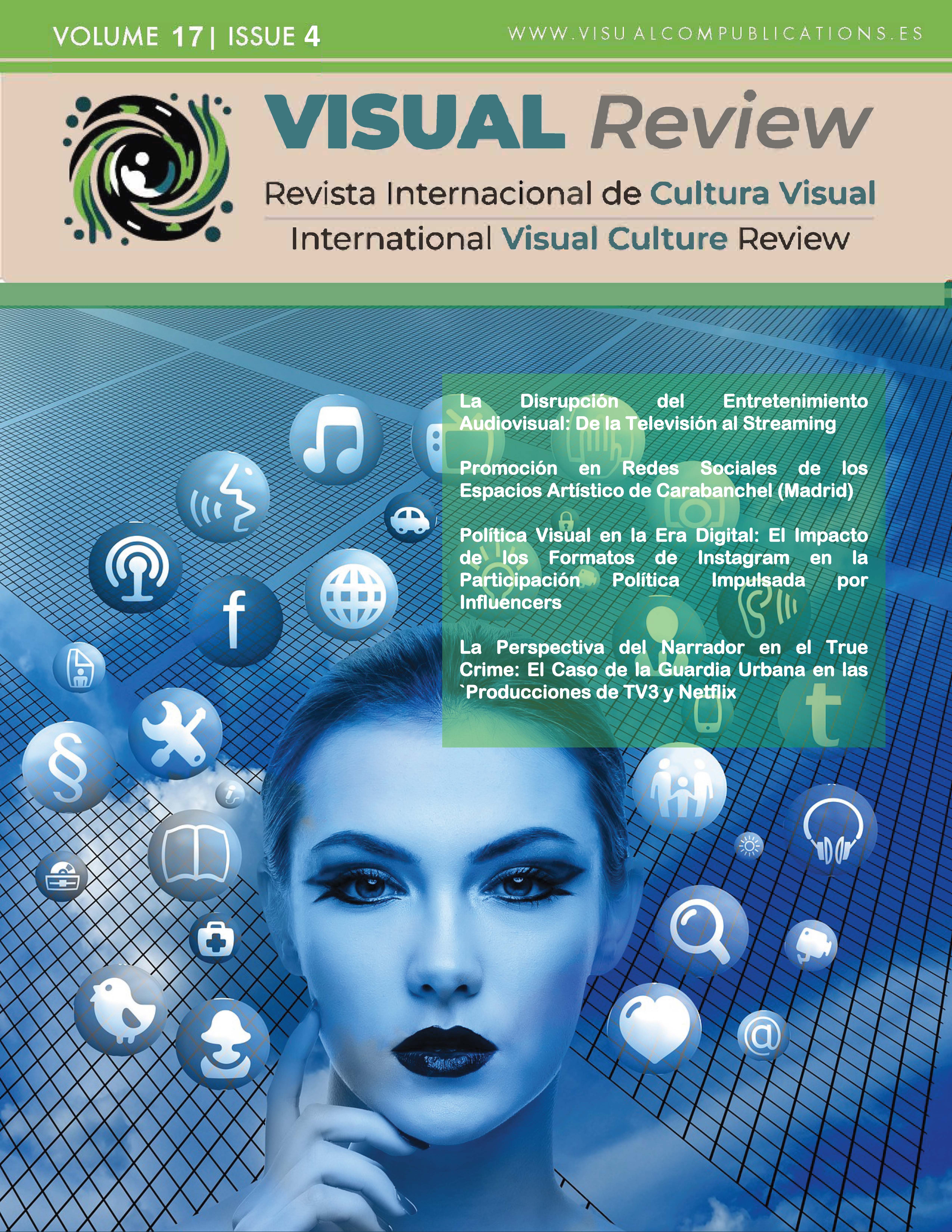Comportamiento del Consumidor Latinoamericano ante los Dramas Coreanos
Un Estudio Netnográfico de la Marca Cultural Coreana
DOI:
https://doi.org/10.62161/revvisual.v17.5706Palabras clave:
Comportamiento del consumidor, K-Dramas, Cultura coreana, Netnografía, Marca cultural, TikTok, Redes socialesResumen
Los K-Dramas han emergido como un fenómeno cultural global en la última década. Esta investigación examina su influencia en el comportamiento del consumidor y la percepción de la marca cultural surcoreana en América Latina a través de un análisis netnográfico de las interacciones en TikTok. Utilizando minería de datos, Atlas.ti y EmojiCloudAPP, se evidenció una fuerte conexión emocional de los espectadores, preferencia por contenidos subtitulados en idioma original y un impacto significativo en el consumo de productos surcoreanos (comida, moda y belleza), actuando como puente cultural entre Corea del Sur y América Latina.
Descargas
Estadísticas globales ℹ️
|
764
Visualizaciones
|
558
Descargas
|
|
1322
Total
|
|
Citas
Aaker, D. (2012). Building Strong Brands. Simon & Schuster UK. https://books.google.com.pe/books?id=OLa_9LePJlYC
Abdalla, A., Bhat, M., Tiwari, C., Khan, S., & Wedajo, A. (2024). Exploring ChatGPT adoption among business and management students through the lens of diffusion of Innovation Theory. Computers and Education: Artificial Intelligence, 7, 100257. https://doi.org/10.1016/j.caeai.2024.100257 DOI: https://doi.org/10.1016/j.caeai.2024.100257
Abigail, J., Sari, V., & Saputra, D. (2024). The Influence of Product Quality and Online Shopping Experience (OSE) on Consumer Loyalty Through Customer Satisfaction on Local Skincare Products. Procedia Computer Science, 234, 537-544. https://doi.org/10.1016/j.procs.2024.03.037 DOI: https://doi.org/10.1016/j.procs.2024.03.037
Alsina, M. (2018). Teorías de la comunicación: Ámbitos, métodos y perspectivas. Universidad de València Servicio de Publicaciones. https://books.google.com.pe/books?id=Oep6DwAAQBAJ
Ardèvol, E., Bertran, M., Callén, B., & Pérez, C. (2003). Virtualized ethnography: On-line participant observation and semi-structured interview. Athenea Digital. Revista de pensamiento e investigación social, 1(3). https://doi.org/10.5565/rev/athenead/v1n3.67 DOI: https://doi.org/10.5565/rev/athenead/v1n3.67
Ariffin, J. T., Abu Bakar, Dr. H., & Yusof, Dr. N. H. (2018). Culture in Korean Drama towards Influencing Malaysian Audiences. International Journal of Innovative Research in Engineering & Management, 5(1), 10-14. https://doi.org/10.21276/ijirem.2018.5.1.3 DOI: https://doi.org/10.21276/ijirem.2018.5.1.3
Barraza, J., Alatorre, J., & Vizcaíno, A. (2021). El éxito comercial del “K-Drama”: Lecciones para aprender. Comuni@cción: Revista de Investigación en Comunicación y Desarrollo, 12(4), Article 4. https://doi.org/10.33595/2226-1478.12.4.565 DOI: https://doi.org/10.33595/2226-1478.12.4.565
Baudrillard, J. (1998). The Consumer Society: Myths and Structures. https://doi.org/10.4135/9781526401502 DOI: https://doi.org/10.4135/9781526401502
Bhabha, H. (2004). The Location of Culture. Routledge. https://books.google.com.pe/books?id=p7quDTSmYRYC
Calvo, A., Aurrekoetxea-Casaus, M., & Borrajo, E. (2024). Virtual Ethnography of Female Migrants: A WhatsApp Group as a Support Tool During Their Migration Process. Journal of International Migration and Integration, 25(2), 553-571. https://doi.org/10.1007/s12134-023-01088-8 DOI: https://doi.org/10.1007/s12134-023-01088-8
Cayaban, C., Prasetyo, Y., Persada, S., Mariñas, K., Nadlifatin, R., Borres, R., & Gumasing, M. (2023). Factors Affecting Filipino Consumer Behavior with Korean Products and Services: An Extended Theory of Planned Behavior Approach. Sustainability (Switzerland), 15(5). Scopus. https://doi.org/10.3390/su15054477 DOI: https://doi.org/10.3390/su15054477
Cohen, J. (2001). Defining Identification: A Theoretical Look at the Identification of Audiences With Media Characters. Mass Communication and Society, 4(3), 245-264. https://doi.org/10.1207/S15327825MCS0403_01 DOI: https://doi.org/10.1207/S15327825MCS0403_01
Cueva, R., Camino, J., & Ayala, V. (2013). Conducta del consumidor: Estrategias y políticas aplicadas al marketing. ESIC Editorial. https://books.google.com.pe/books?id=-eb2AQAAQBAJ
De Mooij, M. (2004). Consumer Behavior and Culture: Consequences for Global Marketing and Advertising. SAGE Publications. https://books.google.com.pe/books?id=YMOmwgs-EQMC
Falgoust, G., Winterlind, E., Moon, P., Parker, A., Zinzow, H., & Chalil Madathil, K. (2022). Applying the uses and gratifications theory to identify motivational factors behind young adult’s participation in viral social media challenges on TikTok. Human Factors in Healthcare, 2, 100014. https://doi.org/10.1016/j.hfh.2022.100014 DOI: https://doi.org/10.1016/j.hfh.2022.100014
Gauttam, P., Singh, B., Singh, S., Bika, S. L., & Tiwari, R. P. (2024). Education as a soft power resource: A systematic review. Heliyon, 10(1), e23736. https://doi.org/10.1016/j.heliyon.2023.e23736 DOI: https://doi.org/10.1016/j.heliyon.2023.e23736
Glodev, V., Wijaya, G., & Ida, R. (2023). The Korean Wave as the Globalization of South Korean Culture. WACANA: Jurnal Ilmiah Ilmu Komunikasi, 22(1), Article 1. https://doi.org/10.32509/wacana.v22i1.2671 DOI: https://doi.org/10.32509/wacana.v22i1.2671
Han, B. (2019). Fantasies of Modernity: Korean TV Dramas in Latin America. Journal of Popular Film and Television, 47(1), 39-47. https://doi.org/10.1080/01956051.2019.1562823 DOI: https://doi.org/10.1080/01956051.2019.1562823
Hirschman, E. C., & Holbrook, M. (1982). Hedonic Consumption: Emerging Concepts, Methods and Propositions. Journal of Marketing, 46(3), 92-101. https://doi.org/10.1177/002224298204600314 DOI: https://doi.org/10.1177/002224298204600314
Huang, J., Xiao, W., & Wang, Y. (2023). Use of metadiscourse for identity construction in tourist city publicity:A comparative study of Chinese and Australian social media discourse. Heliyon, 9(12), e23122. https://doi.org/10.1016/j.heliyon.2023.e23122 DOI: https://doi.org/10.1016/j.heliyon.2023.e23122
Jin, D. (2024). AI in cultural production in the Korean cultural industries. Telematics and Informatics Reports, 13, 100113. https://doi.org/10.1016/j.teler.2023.100113 DOI: https://doi.org/10.1016/j.teler.2023.100113
Kang, J., & Ro, H. (2024). The Role of Brand Authenticity and Existential Authenticity in Building Brand Loyalty Toward LGBT-Friendly Hotels. Journal of Hospitality & Tourism Research, 10963480241244727. https://doi.org/10.1177/10963480241244727 DOI: https://doi.org/10.1177/10963480241244727
Kim, S., Agrusa, J., Lee, H., & Chon, K. (2007). Effects of Korean television dramas on the flow of Japanese tourists. Tourism Management, 28(5), 1340-1353. https://doi.org/10.1016/j.tourman.2007.01.005 DOI: https://doi.org/10.1016/j.tourman.2007.01.005
Ko, E. (Emily), Kim, D., & Kim, G. (2022). Influence of emojis on user engagement in brand-related user generated content. Computers in Human Behavior, 136, 107387. https://doi.org/10.1016/j.chb.2022.107387 DOI: https://doi.org/10.1016/j.chb.2022.107387
Kozinets, R. V. (2020). Netnography: The essential guide to qualitative social media research (3E ed.). SAGE. DOI: https://doi.org/10.4324/9781003001430-2
Lee, C.-K., Yoon, Y.-S., & Lee, S.-K. (2007). Investigating the relationships among perceived value, satisfaction, and recommendations: The case of the Korean DMZ. Tourism Management, 28(1), 204-214. https://doi.org/10.1016/j.tourman.2005.12.017 DOI: https://doi.org/10.1016/j.tourman.2005.12.017
Luo, M. M. (2021). Uses and gratifications theory and digital media use: The test of emotional factors. PEOPLE: International Journal of Social Sciences, 6(01), Article 01. https://doi.org/10.20319/pijss.2020.61.599608 DOI: https://doi.org/10.20319/pijss.2020.61.599608
Messerli, T. C., & Locher, M. A. (2021). Humour support and emotive stance in comments on Korean TV drama. Journal of Pragmatics, 178, 408-425. https://doi.org/10.1016/j.pragma.2021.03.001 DOI: https://doi.org/10.1016/j.pragma.2021.03.001
Min, W., Jin, D. Y., & Han, B. (2019). Transcultural fandom of the Korean Wave in Latin America: Through the lens of cultural intimacy and affinity space. Media, Culture & Society, 41(5), 604-619. https://doi.org/10.1177/0163443718799403 DOI: https://doi.org/10.1177/0163443718799403
Nguyen, X. (2019). Factors Impacting on Korean Consumer Goods Purchase Decision of Vietnam’s Generation Z. Korea Open Access Journals(KOAJ), 17(10). https://www.kci.go.kr/kciportal/landing/article.kci?arti_id=ART002514807 DOI: https://doi.org/10.15722/jds.17.10.201910.61
Nusta, K., Jeong, K., Song, N., & Simoes, R. G. (2014). The Korean Wave Hallyu in Looking at Escapism in Peruvian Society. https://doi.org/10.1163/15691497-12341305 DOI: https://doi.org/10.1163/15691497-12341305
Nye, Jr. (2005). Soft Power: The Means to Success in World Politics. PublicAffairs Books.
Ohnesorge, H. W. (2019). Soft Power: The Forces of Attraction in International Relations. Springer International Publishing. https://books.google.com.pe/books?id=BOK_DwAAQBAJ
Pang, B., & Lee, L. (2008). Opinion Mining and Sentiment Analysis. Foundations and Trends® in Information Retrieval, 2(1–2), 1-135. https://doi.org/10.1561/1500000011 DOI: https://doi.org/10.1561/1500000011
Quinton, S., & Reynolds, N. (2024). Understanding Research in the Digital Age (De pages 7-26). SAGE Publications Ltd. https://doi.org/10.4135/9781529793710 DOI: https://doi.org/10.4135/9781529793710
Radwan, M. (2022). Effect of social media usage on the cultural identity of rural people: A case study of Bamha village, Egypt. Humanities and Social Sciences Communications, 9(1), 1-14. https://doi.org/10.1057/s41599-022-01268-4 DOI: https://doi.org/10.1057/s41599-022-01268-4
Rogers, E. M. (2003). Diffusion of Innovations. Free Press. https://books.google.com.pe/books?id=9U1K5LjUOwEC
Ruiz Olabuénaga, J. I. (2014). Metodología de la investigación cualitativa. Universidad de Deusto. https://books.google.es/books?id=WdaAt6ogAykC&printsec=copyright&hl=es#v=onepage&q&f=false
Saenz Lopez, K., & Tamez González, G. (Eds.). (2014). Métodos y técnicas cualitativas y cuantitativas aplicables a la investigación en ciencias sociales. Tirant Humanidades México.
Safranj, J. (2015). Advancing Listening Comprehension Through Movies. Procedia - Social and Behavioral Sciences, 191, 169-173. https://doi.org/10.1016/j.sbspro.2015.04.513 DOI: https://doi.org/10.1016/j.sbspro.2015.04.513
Saleem, H., Hatim, J., & Jaweria, B. (2023). Youth Perspectives on Korean Dramas: Effects and Responses. Global Multimedia Review, VI(I), 53-61. https://doi.org/10.31703/gmmr.2023(VI-I).05 DOI: https://doi.org/10.31703/gmmr.2023(VI-I).05
Schiffman, L., Kanuk, L., & Wisenblit, J. (2010). Comportamiento del consumidor (10a ed). Pearson Educación.
Shalahuddin, M. A., & Fajrianti, L. (2024). The Impact of Emoticons in Social Media Communication. PROPAGANDA, 4(2), Article 2. https://doi.org/10.37010/prop.v4i2.1632 DOI: https://doi.org/10.37010/prop.v4i2.1632
Solis, M. N. G., & Castilla, M. H. M. (2023, octubre 3). The Fan Community of Korean Celebrities in Peru, as an Advertising Tool to Promote Various Brands, BTS Case. https://www.atlantis-press.com/proceedings/icomta-23/125992193
Stark, B., & Schneiders, P. (2022). Uses and Gratifications Research. https://doi.org/10.1007/978-3-658-37354-2_4 DOI: https://doi.org/10.1007/978-3-658-37354-2_4
Sukendi, J., Siregar, R., Wansaga, S., & Gunadi, W. (2023). Influencing Factors of K-Drama Satisfaction and their Impacts on Fanaticism and Behavioral Intention. European Journal of Business and Management Research, 8(3), Article 3. https://doi.org/10.24018/ejbmr.2023.8.3.1930 DOI: https://doi.org/10.24018/ejbmr.2023.8.3.1930
Tajfel, H. (1982). Social Psychology of Intergroup Relations. https://doi.org/10.1146/annurev.ps.33.020182.000245 DOI: https://doi.org/10.1146/annurev.ps.33.020182.000245
Torelli, C. J., Özsomer, A., Carvalho, S. W., Keh, H. T., & Maehle, N. (2012). Brand Concepts as Representations of Human Values: Do Cultural Congruity and Compatibility between values Matter? Journal of Marketing, 76(4), 92-108. https://doi.org/10.1509/jm.10.0400 DOI: https://doi.org/10.1509/jm.10.0400
Vega, M. (2024). El impacto del Hallyu en México: Un análisis integral de su influencia cultural y social. A&H Revista de Artes, Humanidades y Ciencias Sociales, 19, Article 19.
Wang, X., Zheng, J., Tang, L., & Luo, Y. (2023). Recommend or not? The influence of emotions on passengers’ intention of airline recommendation during COVID-19. Tourism Management, 95, 104675. https://doi.org/10.1016/j.tourman.2022.104675 DOI: https://doi.org/10.1016/j.tourman.2022.104675
Whiting, A., & Williams, D. (2013). Why people use social media: A uses and gratifications approach. Qualitative Market Research: An International Journal, 16(4), 362-369. https://doi.org/10.1108/QMR-06-2013-0041 DOI: https://doi.org/10.1108/QMR-06-2013-0041
Widianingrum, N. A., & Harsono, H. (2023). The Influence of Korean Culture on The Lifestyle of Students At Raden Mas Said State Islamic University: Positive and Negative Impacts on Family Education and The Modern Environment. JHSS (JOURNAL OF HUMANITIES AND SOCIAL STUDIES), 7(3), Article 3. https://doi.org/10.33751/jhss.v7i3.9063
Williams, H., & Thorne, D. (2000). The value of teletext subtitling as a medium for language learning. System, 28(2), 217-228. https://doi.org/10.1016/S0346-251X(00)00008-7 DOI: https://doi.org/10.1016/S0346-251X(00)00008-7
Williams, J. (2016). Authenticity in Culture, Self, and Society. Routledge. https://doi.org/10.4324/9781315261973 DOI: https://doi.org/10.4324/9781315261973
Witt, U. (2010). Symbolic consumption and the social construction of product characteristics. Structural Change and Economic Dynamics, 21(1), 17-25. https://doi.org/10.1016/j.strueco.2009.11.008 DOI: https://doi.org/10.1016/j.strueco.2009.11.008
Xie, C., & Sun, Z. (2021). Influence of perceived quality on customer satisfaction in different stages of services. Nankai Business Review International, 12(2), 258-280. https://doi.org/10.1108/NBRI-01-2020-0004 DOI: https://doi.org/10.1108/NBRI-01-2020-0004
Yamaguchi, K. (1994). The flow of information through social networks: Diagonal-free measures of inefficiency and the structural determinants of inefficiency. Social Networks, 16(1), 57-86. https://doi.org/10.1016/0378-8733(94)90011-6 DOI: https://doi.org/10.1016/0378-8733(94)90011-6
Zarco, L. (2018). Difusión de dramas coreanos, un análisis de su éxodo a América Latina y Colombia. Revista Palobra palabra que obra, 18, 82-98. https://doi.org/10.32997/2346-2884-vol.0-num.18-2018-2165 DOI: https://doi.org/10.32997/2346-2884-vol.0-num.18-2018-2165
Zeithaml, V. A. (1988). Consumer Perceptions of Price, Quality, and Value: A Means-End Model and Synthesis of Evidence. Journal of Marketing, 52(3), 2-22. https://doi.org/10.1177/002224298805200302 DOI: https://doi.org/10.1177/002224298805200302
Software Reference & Online Pages
ATLAS.ti Scientific Software Development GmbH. (2024). ATLAS.ti. Retrieved from https://atlasti.com/
Espinoza-González, V. (2024). Emoji Cloud App: Extract and Visualize Emojis from Text (v1.0). Zenodo. https://doi.org/10.5281/zenodo.13835086
Levallois, Clement. "Umigon: Sentiment analysis on Tweets based on terms lists and heuristics". Proceedings of the 7th International Workshop on Semantic Evaluation(SemEval), 2013, Atlanta, Georgia. https://nocodefunctions.com/
Nocode Functions. (2024.). Nocode Functions. Retrieved from https://nocodefunctions.com/
QSR International. (2024.). NVivo. Retrieved from https://www.qsrinternational.com/nvivo-qualitative-data-analysis-software/home
Descargas
Publicado
Cómo citar
Número
Sección
Licencia
Derechos de autor 2025 Los autores/as conservan los derechos de autor y ceden a la revista el derecho de la primera publicación y el derecho de edición

Esta obra está bajo una licencia internacional Creative Commons Atribución-SinDerivadas 4.0.
Los autores/as que publiquen en esta revista aceptan las siguientes condiciones:
- Los autores/as conservan los derechos de autor.
- Los autores/as ceden a la revista el derecho de la primera publicación. La revista también posee los derechos de edición.
- Todos los contenidos publicados se regulan mediante una Licencia Atribución/Reconocimiento-SinDerivados 4.0 Internacional. Acceda a la versión informativa y texto legal de la licencia. En virtud de ello, se permite a terceros utilizar lo publicado siempre que mencionen la autoría del trabajo y a la primera publicación en esta revista. Si transforma el material, no podrá distribuir el trabajo modificado.
- Los autores/as pueden realizar otros acuerdos contractuales independientes y adicionales para la distribución no exclusiva de la versión del artículo publicado en esta revista (p. ej., incluirlo en un repositorio institucional o publicarlo en un libro) siempre que indiquen claramente que el trabajo se publicó por primera vez en esta revista.
- Se permite y recomienda a los autores/as a publicar su trabajo en Internet (por ejemplo en páginas institucionales o personales), una vez publicado en la revista y citando a la misma ya que puede conducir a intercambios productivos y a una mayor y más rápida difusión del trabajo publicado (vea The Effect of Open Access).













